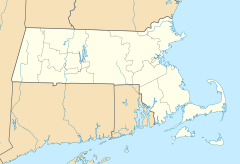University of Massachusetts
 | |
| Type | Public university system |
|---|---|
| Established | 1863 (Amherst campus) 1964 (UMass system) |
| Endowment | $1.5 billion (2024)[1] |
| Budget | $3.79 billion (FY 2023)[2] |
| President | Marty Meehan |
Administrative staff | 17,506[3] |
| Students | 74,000 (2019)[4] |
| Location | , United States |
| Campus | UMass Amherst UMass Boston UMass Dartmouth UMass Lowell UMass Chan Medical School UMass School of Law |
| Nickname | UMass |
| Website | massachusetts.edu |
The University of Massachusetts is the five-campus public university system in the Commonwealth of Massachusetts. The university system includes six campuses (Amherst, Boston, Dartmouth, Lowell, a medical school in Worcester and a law school in Dartmouth), a satellite campus in Springfield[5][6] and 25 smaller campuses throughout California and Washington with the University of Massachusetts Global.
The University of Massachusetts system is governed by a president[7] and a 22-member board of trustees.[8][8] The system administration is in Boston and Shrewsbury,[9] is accredited by the New England Commission of Higher Education, and across its campuses enrolled 73,593 students in fall 2023.[4]
Campuses
[edit]The University of Massachusetts Amherst is the largest school in the UMass system. It was also the first one established, dating back to 1863, when it was founded as the Massachusetts Agricultural College. The University of Massachusetts Chan Medical School was founded in 1962, and is located in Worcester. The University of Massachusetts Boston, originally established in 1964, was merged with Boston State College in 1982. In 1991, the University of Lowell and Southeastern Massachusetts University joined the system as the University of Massachusetts Lowell and University of Massachusetts Dartmouth, respectively.
University of Massachusetts Amherst
[edit]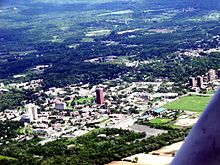
Amherst is the flagship and the largest of the UMass campuses, as well as the first established. Like many colleges and universities, the Massachusetts Agricultural College (as it was originally called) in Amherst was founded as a land-grant college in 1863, receiving initial start-up funding as part of the Morrill Land-Grant Colleges Act. It became "Massachusetts State College" in 1931, and "University of Massachusetts" in 1947. The library system is the largest state-supported library system in New England with over 6.1 million items.
Students participate in 240 campus organizations, 21 NCAA Division I athletic teams, living-learning residence halls, community service, internships, and faculty research. Massachusetts is also part of the Five Colleges consortium, with Smith, Mount Holyoke, Hampshire, and Amherst colleges, all within a free bus ride of each other using the Pioneer Valley Transit Authority. Students can take classes on any of these campuses and participate in all co-curricular and cultural activities.[10]
University of Massachusetts Boston
[edit]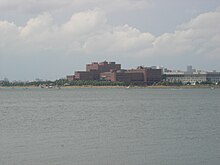
UMass Boston is a research university[11] located in the City of Boston. Located on the Columbia Point peninsula, the university is surrounded by the Boston Harbor, the John F. Kennedy Library and the Massachusetts State Archives. The Boston Globe is also headquartered adjacent to campus, as well as Boston College High School. Subsequently, the university holds many partnerships with its neighboring organizations, providing research and employment opportunities.
UMass Boston enrolls more than 12,000 undergraduates and nearly 4,000 graduate students, making it the third largest campus in the system.[12] The university has five undergraduate colleges and two graduate colleges, with over 100 undergraduate programs and 50 graduate programs.[13] The campus is also home to more than 100 student organizations—including clubs, literary magazines, newspaper, radio station, art gallery, and 16 NCAA Division III sports teams.[13]
University of Massachusetts Dartmouth
[edit]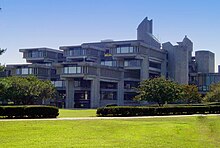
Located in southeastern Massachusetts, UMass Dartmouth started in 1895 as the New Bedford Textile School, the Bradford Durfee Textile School, and later Southeastern Massachusetts University (SMU). In addition to the 710-acre (2.9 km2) UMass Dartmouth main campus is, satellite campuses are located throughout the SouthCoast.[14]
The university has nearly 8,000 students and 65 degree programs in its College of Arts & Sciences; Charlton College of Business; College of Engineering; College of Nursing; College of Visual and Performing Arts; School of Education, Public Policy, and Civic Engagement; and the School for Marine Science and Technology. The university hosts internships, undergraduate research opportunities, and service learning experiences, as well as an Honors Program.[14]
The university has more than 100 student organizations and 25 NCAA Division III athletic teams. The buildings of the campus were designed by internationally renowned Modernist architect Paul Rudolph.
The University of Massachusetts School of Law was opened in September 2010 three miles from the Dartmouth campus.
University of Massachusetts Lowell
[edit]
UMass Lowell is the product of a 1971 merger between Lowell State College (founded in 1894 as Lowell Normal School) and Lowell Technological Institute (founded in 1895 as the Lowell Textile School). The merged institution became the University of Lowell, with the former Lowell Tech serving as the North Campus and the former Lowell State serving as the South Campus.
UMass Lowell is a comprehensive University with a national reputation in science, engineering, Management and technology, and committed to educating students for lifelong success in a diverse world and conducting research and outreach activities that sustain the economic, environmental and social health of the region.
UMass Lowell is located in the Merrimack Valley.[15] It had a total of 18,316[16] students as of fall 2017 and is the fastest growing of the five UMass campuses.[17] The campus offers over 120 programs taught by 737 faculty members in five colleges.[15]
There are 12 residence halls on the campus. There are more than 120 active student organizations on campus, a campus recreation center, 16 NCAA Division I sports teams that compete in the America East Conference, and the ice hockey team that competes in the Hockey East Conference.
University of Massachusetts Chan Medical School
[edit]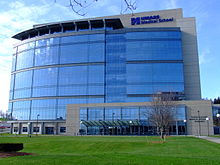
The University of Massachusetts Worcester, also known as UMass Chan Medical School or UMass Medical School is one of the fastest growing academic health science centers in the country and is home to the School of Medicine (SOM) — the Commonwealth's only public medical school — the Graduate School of Biomedical Sciences (GSBS), the Graduate School of Nursing (GSN), and a research enterprise that attracts more than $200 million in external funding annually.[18] Its 63-acre (250,000 m2) campus is shared with clinical partner UMass Memorial Health Care, the region's largest employer.[18]
The work of UMass Chan Medical researcher and 2006 Nobel Prize winner Craig Mello, an investigator of the prestigious Howard Hughes Medical Institute, toward the discovery of RNA interference has launched a promising new field of research. The school is also the home of the Albert Sherman Center, an interdisciplinary, research and education facility that fosters collaboration among scientists and innovation across disciplines.[18]
University of Massachusetts School of Law
[edit]The University of Massachusetts School of Law also known as the University of Massachusetts - Dartmouth Law School, UMass Law School or UMass Law is located near the main campus of UMass Dartmouth in North Dartmouth, Massachusetts and is also a part of UMass Dartmouth.[19]
UMass Law was established in 1981 as the Southeastern Massachusetts-Rhode Island-Avins Law School with a volunteer faculty and a handful of part-time students. It grew from a store-front operation, offering a weekend program of study in Fall River, Massachusetts to a dual-division law school located in its own state-of-the-art facility in North Dartmouth, Massachusetts.[19]
In 1986 the Southeastern Massachusetts-Rhode Island-Avins Law School became the Southern New England School of Law (SNESL). In 1992 the first full-time program at SNESL was established along with SNESL's first day classes. In 1994 SNESL moved to its new current site at 333 Faunce Corner Road in North Dartmouth, Massachusetts. In 1995 SNESL was Accredited by New England Association of Schools and Colleges. In 2009 University of Massachusetts Board of Trustees approves UMass Dartmouth plan to offer Juris Doctor (JD) degrees at SNESL.[19]
In 2010 the Massachusetts Board of Higher Education authorized UMass Dartmouth to offer JD degrees along with the establishment of the University of Massachusetts School of Law - Dartmouth (UMass Law). UMass Law was made possible by a $23 million donation of assets, a facility, land, library, technology, and cash from the Southern New England School of Law. In 2010 at the time of the donation from SNESL, SNESL had 1,200 alumni, 200 students, 13 full-time faculty members, and 24 adjunct faculty.[19]
Also in 2010 the first UMass Law class matriculates. In 2011 UMass Law confers their first JD degrees. In 2012 UMass Law was granted provisional approval by Council of the Section of Legal Education and Admissions to the Bar of the American Bar Association with full accreditation being granted four years later.[19]
UMass Amherst Center at Springfield
[edit]On August 8, 2013, the University of Massachusetts started requesting proposals for potential classroom and office space to establish a satellite center in Springfield. UMass was looking for 25,000 square feet of space that it would use for classrooms, faculty offices and other uses, with the option of doubling the amount of space at a later date.[20] On November 23, 2013, Gov. Deval Patrick and University of Massachusetts President Robert L. Caret announced the selection of Tower Square in downtown Springfield as the university's new satellite center. The university would lease 27,321 square feet on the second floor of the 30-floor building, which is owned by the Massachusetts Mutual Life Insurance Co. and located at 1500 Main St. UMass planned to establish academic programs at the center starting in the fall 2014.[21]
In 2014, the state of Massachusetts gave $5.2 million[22] to the Springfield satellite center to allow the university to complete construction and buy furnishings. .[23][24]
The satellite center, administered by the Amherst campus, opened in March 2014, registering students for September 2014.[25] Programs include nursing, education, business administration, addiction counseling, and GED classes.[26] Enrollment in the more than 20 courses offered at the center has grown from 250 students in the fall of 2014 when it opened to 850 in the spring of 2016, according to Daniel Montagna, director of operations at the center. The institution offers a cybersecurity certificate program funded in 2017 by a $5 million investment by MassMutual.[27]
University of Massachusetts Global
[edit]In September 2021, Brandman University reaffiliated with the University of Massachusetts from Chapman University via a change of control agreement and rebranded as UMass Global.[28]
Research
[edit]Collaborations
[edit]The Massachusetts Green High Performance Computing Center is a joint venture of the University of Massachusetts system, MIT, Harvard, Boston University, and Northeastern to build a shared high-performance computing facility.[29] In 2010, UMass Boston partnered with Dana–Farber/Harvard Cancer Center to collaborate on research aimed at addressing issues of cancer health disparities in disenfranchised populations under U54 Cancer Partnership.[30]
Inter Campus Programs
[edit]University of Massachusetts Intercampus Graduate School of Marine Sciences and Technology[31] is a graduate degree program offering Master of Science, Doctor of Philosophy and Professional Science Master's Degree.[32] The graduates receive a joint degree from all four of the main UMass campuses.[31]
University president
[edit]The president is the university's chief executive officer and works to advance its mission of education, research and public service. Marty Meehan became the 27th president of the five-campus, 73,000-student University of Massachusetts system on July 1, 2015.
Before the 1962 establishment of the medical school, the president was the administrator of the system's only campus in Amherst. When UMass Boston was organized in 1964, it was headed by a chancellor who reported to the president. In 1970, as part of a reorganization, day-to-day leadership responsibilities for UMass Amherst were transferred to a chancellor, with both chancellors reporting on an equal basis to the president. Today, the president administers five campuses.
| President | Tenure[33] |
|---|---|
| Henry F. French | 1864–1866 |
| Paul A. Chadbourne | 1866–1867 and 1882–1883 |
| William S. Clark | 1867–1879 |
| Charles L. Flint | 1879–1880 |
| Levi Stockbridge | 1876 and 1880–1882 |
| James C. Greenough | 1883–1886 |
| Henry H. Goodell | 1883 and 1886–1905 |
| William P. Brooks | 1905–1906 |
| Kenyon L. Butterfield | 1906–1924 |
| Edward M. Lewis | 1924–1927 |
| Roscoe W. Thatcher | 1927–1932 |
| Hugh P. Baker | 1933–1947 |
| Ralph A. Van Meter | 1947–1954 |
| Jean Paul Mather | 1954–1960 |
| John W. Lederle | 1960–1970 |
| Robert C. Wood | 1970–1977 |
| Franklin K. Patterson | 1978 (interim) |
| David C. Knapp | 1978–1990 |
| Joseph D. Duffey | 1990–1991 |
| E. K. Fretwell | 1991–1992 (interim) |
| Michael Hooker | 1992–1995 |
| Sherry H. Penney | 1995–1996 (interim) |
| William Bulger | 1996–2003 |
| Jack M. Wilson | 2003–2011 |
| Robert Caret | 2011–2015 |
| Marty Meehan | 2015– |
Board of trustees
[edit]The University of Massachusetts is governed by a board of trustees that functions as a legislative body dealing mainly with questions of policy. The board establishes the general policies governing the university, but has delegated many powers to the president and, through the president, to campus administrators for day-to-day-operations. In certain rare instances when required by the Massachusetts General Laws, it may function as an appeal body.
The founding board had fourteen appointed members and four ex-officio members. Formerly, trustees were appointed by the legislature or the board itself; currently, members are appointed by the governor. The size of the board has fluctuated between twelve and twenty-four members. The current board is composed of nineteen voting members and three ex-officio non-voting members. Seventeen board members are appointed by the governor of the Commonwealth; at least five of those appointed must be alumni of the university, and one must be a representative of organized labor. The other two voting members are students. Overall, the board has five student members, elected for one-year terms, from the Amherst, Boston, Dartmouth, Lowell, and Worcester campuses. Voting membership rotates among the campuses: two students are voting members and three others are non-voting members.
References
[edit]- ^ "Endowment Overview".
- ^ "UMass Facts 2022" (PDF). Retrieved January 25, 2024.
- ^ "University of Massachusetts system - Institution Research Facts" (PDF). University of Massachusetts Office of the President. December 4, 2015. Archived from the original (PDF) on November 13, 2018. Retrieved December 4, 2015.
- ^ a b "Quick Facts". Archived from the original on November 12, 2020. Retrieved November 6, 2021.
- ^ "UMass Opens Springfield Center Campus Office". WAMC/Northeast Public Radio. March 31, 2014. Archived from the original on March 10, 2015. Retrieved April 3, 2014.
- ^ "UMass' Springfield center holds opening ceremony". boston.com. Archived from the original on April 7, 2014. Retrieved April 3, 2014.
- ^ "President - University of Massachusetts". University of Massachusetts. Retrieved May 15, 2023.
- ^ a b "Board of Trustees - University of Massachusetts". University of Massachusetts. Retrieved May 15, 2023.
- ^ "About - University of Massachusetts Office of the President". Archived from the original on March 23, 2016. Retrieved April 1, 2016.
- ^ "Massachusetts.edu". Massachusetts.edu. Archived from the original on July 5, 2012. Retrieved December 13, 2011.
- ^ "Carnegie Classification". Carnegie Foundation for the Advancement of Teaching. Retrieved July 18, 2010.
- ^ "About – Quick Facts | University of Massachusetts".
- ^ a b "UMass Boston". University of Massachusetts. Archived from the original on September 5, 2012. Retrieved December 13, 2011.
- ^ a b "Massachusetts.edu". Massachusetts.edu. Archived from the original on December 5, 2011. Retrieved December 13, 2011.
- ^ a b "Massachusetts.edu". Massachusetts.edu. Archived from the original on December 28, 2012. Retrieved December 13, 2011.
- ^ "UMass Lowell 2018 Report Card" (PDF). Archived (PDF) from the original on December 10, 2020. Retrieved April 29, 2018.
- ^ "This page/site is temporarily unavailable" (PDF). Archived from the original (PDF) on May 22, 2014. Retrieved May 22, 2014.
- ^ a b c "Massachusetts.edu". Massachusetts.edu. Archived from the original on November 6, 2012. Retrieved December 13, 2011.
- ^ a b c d e Law, UMass. "History". www.umassd.edu. Archived from the original on September 15, 2021. Retrieved September 15, 2021.
- ^ "UMass requests proposals for Springfield satellite center". masslive.com. August 6, 2013. Archived from the original on September 23, 2017. Retrieved September 23, 2017.
- ^ "UMass chooses Tower Square as location for Springfield satellite center". masslive.com. November 26, 2013. Archived from the original on September 23, 2017. Retrieved September 23, 2017.
- ^ "Deval Patrick touts $5.2 million investment in UMass Springfield satellite center as vital for education, economic development". MassLive.com. May 2014. Archived from the original on May 12, 2014. Retrieved May 9, 2014.
- ^ "Outlook 2014: What will be the academic focus of the new UMass Springfield satellite center?". MassLive.com. February 3, 2014. Archived from the original on February 26, 2015. Retrieved May 9, 2014.
- ^ "State giving UMass $5 million to complete Springfield work". Boston Business Journal. Archived from the original on May 16, 2014. Retrieved May 9, 2014.
- ^ Tuthill, Paul (March 31, 2014). "UMass Opens Springfield Center Campus Office". Archived from the original on March 10, 2015. Retrieved December 22, 2015.
- ^ "Program Offerings". Archived from the original on August 5, 2020. Retrieved December 22, 2015.
{{cite web}}: CS1 maint: unfit URL (link) - ^ "UMass Center in downtown Springfield fulfilling promise as base for academics, community engagement". masslive.com. February 15, 2017. Archived from the original on September 23, 2017. Retrieved September 23, 2017.
- ^ Lederman, Doug (September 3, 2021). "Brandman University, adult-serving online institution, to become UMass Global". Inside Higher Education. Archived from the original on December 9, 2021. Retrieved October 22, 2021.
- ^ "High-tech computing center on track" Archived February 21, 2014, at the Wayback Machine, Boston Globe, October 22, 2009
- ^ "The UMass Boston - Dana-Farber/Harvard Cancer Center". University of Massachusetts Boston. Archived from the original on April 28, 2014. Retrieved April 28, 2014.
- ^ a b "Inter-campus marine program gets approval". SouthCoastToday.com. Archived from the original on May 13, 2014. Retrieved May 13, 2014.
- ^ "University of Massachusetts Intercampus Marine Science". University of Massachusetts. Archived from the original on May 13, 2014. Retrieved May 13, 2014.
- ^ Massachusetts.edu Archived April 19, 2014, at the Wayback Machine, Retrieved January 11, 2009.
External links
[edit]- Official website
- Executive Office of Education, hdl:2452/36527. (Various documents related to University of Massachusetts System.)

